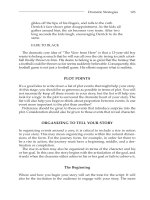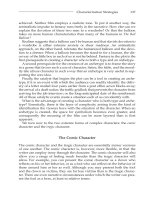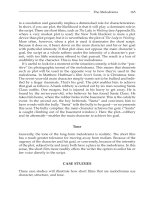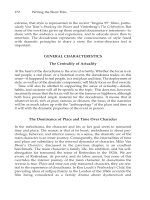Tài liệu Writing the short film 3th - Part 20 docx
Bạn đang xem bản rút gọn của tài liệu. Xem và tải ngay bản đầy đủ của tài liệu tại đây (123.6 KB, 7 trang )
glides off the tips of his fingers, and rolls to the curb.
Derrick’s face shows grim disappointment. As the kids all
gather around him, the air becomes very tense. After two
long seconds the kids laugh, encouraging Derrick to do the
same.
FADE TO BLACK
The dramatic core idea of “The View from Here” is that a 13-year-old boy
wants to belong so much that he will run all over the city trying to catch a foot-
ball finally thrown to him. His desire to belong is so great that the fantasy that
a football could be thrown so far seems suddenly believable. Consequently, this
football game is not just a football game. His efforts surpass what is realistic.
PLOT POINTS
It’s a good idea to write down a list of plot events that might help your story.
At this stage, you should be as generous as possible in terms of plot. You will
not necessarily keep all these events in your story, but the list will help you
look for a logic in the plot to surround the dramatic heart of your story. The
list will also help you begin to think about proportion between events. Is one
event more important to the plot than another?
Preference should be given to those events that introduce surprise into the
plot. Consideration should also be given to those events that reveal character.
ORGANIZING TO TELL YOUR STORY
In organizing events around a core, it is critical to include a rise in action
in your story. This may mean organizing events within the natural dimen-
sions of the form. For the journey form, for example, in order for there to
be a rise in action, the journey must have a beginning, middle, and a des-
tination or completion.
The rise in action may also be organized in terms of the character and his
or her goal. In this case, the story begins with the articulation of the goal, and
it ends when the character either achieves his or her goal or fails to achieve it.
The Beginning
Where and how you begin your story will set the tone for the script. It will
also be the invitation to the audience to engage with your story. The more
Dramatic Strategies 123
Ch10.qxd 9/27/04 6:07 PM Page 123
compelling the opening, the more likely it is that we will be engaged quickly
with your story. This is all the more true with a short script. The opening
should maximize the dramatic possibilities of the story.
Middle
The journey has begun; the event is under way. In the middle of your story,
you must concentrate on the mechanics of the struggle, the confusion, the
desire, so that we understand how difficult the undertaking is for the main
character.
What is notable about the middle of the story is that the character’s goal
seems more difficult to achieve than it did at the beginning of the story. The
journey is now more complicated; the event is not what it seemed. There
may now be doubt that the character can achieve his or her goal.
End
The concluding section of the screen story should answer the question, did
the character achieve his or her goal through dramatic action? Was it as he
or she expected? There also should be a sense that the character has in some
way changed or gained understanding because of having undertaken the
journey or having experienced the event. What has brought him or her to
that understanding should be of greater dramatic intensity than the struggle
of the middle or the articulation of the goal in the beginning.
Climax
One key event takes the character to the summit, and that event is the climax
of the story. This event will involve the resolution of the main character’s
struggle with the antagonist.
THE IMPORTANCE OF SEEKING CREATIVE SOLUTIONS
It is very easy for writers to rely on mechanical solutions to narrative prob-
lems. Transforming an idea into a script means attending to dramatic princi-
ples and forms; however, too often the writer unwittingly falls into the trap
of taking the path of least resistance: the mechanically correct rather than the
creatively desirable dramatic solution.
In essence, avoiding mechanical solutions means keeping your awareness
of, excitement about, and commitment to the original idea in the forefront.
124 Writing the Short Film
Ch10.qxd 9/27/04 6:07 PM Page 124
Only by finding energetic and interesting solutions to problems encountered
in translating your idea into a short film will you end up with a story as
exciting and as interesting as your original idea.
THE ROLE OF ENERGY
Your dramatic story needs a level of energy in the script that keeps the
viewer primed and receptive to the creative solutions you develop. Energy
should come from every source—the frame of your story, the nature of your
character, the character’s goal, and the barriers to that goal.
If you have done your job well, you will not have to write dialogue at the
level of a scream in order to simulate energy in the screenplay. The develop-
ment of polarities and the interjection of an element of surprise will provide
the story with energy.
THE ROLE OF INSIGHT
Surprise and energy lead to insight. When you and I discover something
about a person, a place, a time, something we never knew or had forgotten,
we experience an insight. Just as your main character should experience
insight about him or herself through experiences in the script, so too should
the audience members gain insight about themselves.
All of us want to learn all the time. It’s the great payoff from reading or
viewing stories. When they are very good, they teach us, as all positive and
negative experiences should.
Insights into people, places, and times give us clues to our own lives—
what we want and what we don’t want from our lives. Insights are the
shared moments between writer and viewer, the point at which we are clos-
est. In script writing, they are the most powerful moments in the act of
telling a dramatic story.
EXERCISE 18
Identify two ideas for short films that you will work with in this exercise.
One idea should be autobiographical, a painful incident from the past. One
approach to articulating this idea is to write a letter to a real person who was
not involved in the matter.
A second idea should be drawn from a newspaper, also describing an inci-
dent that captures your interest. Use the incident to write a letter to a person
who was involved in the incident. Write the letter as if the incident happened
to you.
Dramatic Strategies 125
Ch10.qxd 9/27/04 6:07 PM Page 125
Using these two ideas, choose a frame or genre for each story. Once you
have decided upon a genre, answer the following questions and complete
the tasks below:
1. Do you want an intense or a distancing treatment of this story?
2. Name five strategies to intensify your story.
3. Name five strategies to distance us from your story.
4. Identify five potential conflicts in each of your stories.
5. Identify five polarities that you will use in each story.
6. What is the most important idea in your story?
7. How does this idea relate to each of the conflicts in your story?
8. List 10 events or plot points in your story.
9. Organize those events along a rising action.
10. Which event best opens your story?
11. Which event best closes your story?
12. What is the climax of your story?
13. Add three surprises suitable to your story.
NOTES
1. Margaret Drabble, ed., The Oxford Companion to English Literature, 5th ed. (New
York: Oxford University Press, 1985), 335.
2. Two collections of such tales are Yaffa Eliach’s Hasidic Tales of the Holocaust (New
York: Random House, 1988) and Bernard Gotfryde’s Anton the Dove Fancier and
Other Tales of the Holocaust (New York: Washington Square Press, 1990).
3. Jerome Stern, Making Shapely Fiction (New York: Dell, 1991).
4. For an elaborate treatment of this relationship, see K. Dancyger and J. Rush,
Alternative Scriptwriting (Boston: Focal Press, 1991), 154.
5. Adisa Lasana Septuri, “The View From Here,” Graduate Department of Film and
Television, New York University, New York, 1990.
126 Writing the Short Film
Ch10.qxd 9/27/04 6:07 PM Page 126
11
CHARACTERIZATION
STRATEGIES
Who is your story about? Why have you chosen this person? The answers
to these key questions will go far toward helping you write your short
script.
The first impulse of writers of short films is not to spend much time on the
characters. The thinking is that because you have less time, you therefore
need less characterization. This is totally wrong. In fact, your short film relies
principally on character. Unlike in the long film, there is little time to deal
with the complexity of relationships, but the viewers must feel that your
main character has a complexity appropriate to the type of story you choose
to tell. For example, in Incident at Owl Creek, it is true that we don’t have a pro-
found understanding of all the dimensions of the principal character, but we
fully understand his desire to live rather than to die. Similarly, we understand
the two main characters in Two Men and a Wardrobe to be naive in a cynical
world—but at least they believe in something! In both cases we understand
and empathize with the characters in the context of their goals. Short films,
therefore, do not tend to develop complex relationships between characters,
but they do rely on complex characters to tell the story.
Another feature of characterization in the short film is the speed with
which the main character must be established. Again, time constraints mean
that the writing has to exercise considerable economy in characterization.
Here the suggestions of E. M. Forster in his Aspects of the Novel are relevant.
Forster speaks of flat characters and rounded characters. Flat characters, he
says, in their purest form are constructed around a single idea or quality; one
advantage of flat characters is that they are easily recognized whenever they
appear. Rounded characters, however, are more complex and, unlike the flat
ones, are capable of surprising us. A rounded character has the incalculabil-
ity of life about him or her and is a more unpredictable character.
1
127
Ch11.qxd 9/27/04 6:08 PM Page 127









